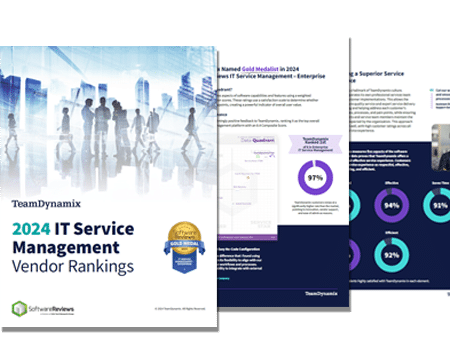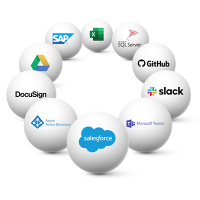
Enterprise Service Management: Why a Unified Platform Matters
Enterprise Service Management (ESM) is the practice of extending IT Service Management (ITSM) principles beyond the IT department to other areas of an organization. ESM

The Info-Tech ranking report offers a unique view of the market based entirely on in-depth customer interviews. Download the Info-Tech ITSM Quadrant and Customer Viewpoint report today.

We’ll show you some of our best situations and show you exactly how to execute them to get immediate results. The best part is, iPaaS tools often feature easy-to-use click and drag functionality, meaning you don’t need a dedicated employee building integrations and workflows.

System Integrators, Value Added Resellers, Technology Providers, and Buying Consortiums can benefit from a partnership with TeamDynamix.

The Info-Tech ranking report offers a unique view of the market based entirely on in-depth customer interviews. Download the Info-Tech ITSM Quadrant and Customer Viewpoint report to gain a better understanding of key vendor strengths and emerging market requirements.
As more and more companies move to support a hybrid work model, many are shoring up processes and implementing methods for completing projects and work.
Many of these project management methods are common in IT practices but are now being expanded to work outside IT across all departments, from marketing and finance to HR. One of the more popular methods is the Agile method.
So, what is Agile? Agile is a project management methodology aimed at rapid development with iterative feedback and communication.
For Agile teams, the concept is ingrained in their day-to-day activities and they use the approach of agile project walls to improve their responses to changing needs and demands. These quick iterations offer a more usable and practical output in the end.
The lower level of formality and structure makes it easier for teams to embrace card walls to track and monitor progress.
Agile teams tend to like the fact that it can be managed with very little effort and stakeholders like the fact that they can understand what was happening without any specialist training around Agile.
In fact, for some organizations, Kanban is the only Agile method they use – not just for communicating progress, but for managing all of the work. Because Agile is so easy to understand and use, it’s very popular outside of IT.
Here are some reasons why Agile is an attractive choice for managing projects both within IT and in departments outside of IT:
Changing requirements: Agile is well-suited for projects with evolving or unclear requirements, as it allows teams to quickly adapt to changes and deliver incremental value to customers. This flexibility ensures that the final product meets customer needs and expectations.
Frequent feedback: Agile emphasizes continuous collaboration with stakeholders and customers, enabling teams to receive regular feedback on their work. This helps in making necessary adjustments and improvements throughout the project, ultimately resulting in a higher-quality product or service.
Reduced risk: By breaking down the project into smaller iterations, Agile makes it easier to identify and address risks early in the development process. This proactive approach to risk management minimizes potential negative impacts and improves the likelihood of project success.
Improved visibility: Agile practices, such as daily stand-ups and sprint reviews, provide greater transparency into the project’s progress. This allows stakeholders to make informed decisions, allocate resources effectively and ensure that the project stays on track.
Increased productivity: Agile encourages cross-functional teams to work together more efficiently, resulting in faster problem-solving and decision-making. This collaborative approach leads to increased productivity and reduced time-to-market.
Better customer satisfaction: Agile’s customer-centric approach ensures that the project focuses on delivering value to the end user. By prioritizing customer needs and involving them throughout the development process, Agile helps create products or services that genuinely address customer problems and expectations.
Employee engagement: Agile empowers team members by providing them with autonomy and ownership over their work. This fosters a positive work environment, leading to increased employee engagement, satisfaction, and retention.
In summary, Agile is great for projects to maximize flexibility, collaboration and customer satisfaction while minimizing risks and ensuring efficient resource allocation. Agile is particularly useful for projects with dynamic requirements, tight deadlines or a need for frequent stakeholder feedback.
Card walls, or walls of work, have become popular because they are so straightforward. They can be produced with nothing more complicated than sticky notes on a whiteboard. Yet they immediately convey a lot of information about the project.
For those working in an office, it’s common to put these card walls outside the team’s work area so anyone stopping by can immediately see what’s going on. And because they are so easy to understand there is no need for them to be analyzed or studied. A sponsor passing by on their way to a meeting can immediately see what’s happening.
For those working outside of the office, many teams use collaboration or work management software that allows for the creation of card walls that can be shared throughout the organization. That makes agile project walls one of the most powerful communication and work management tools available.
Imagine if communications and content creation could go through an agile project wall versus a series of emails and sticky notes. Consider the benefits when it comes to executing critical projects including performance review cycles, events and campaigns. Process enhancement techniques can also be applied to eliminate redundancies and help teams work more cohesively while making better use of their time.
If you are in IT or the PMO, consider a lunch and learn session to help other groups understand how they can be leveraging an Agile project wall for basic project planning. Agile project walls and project delivery methods have grown in popularity. They started life almost 20 years ago in software development, but these walls of work are now widespread in many different departments.
Agile has been widely adopted in various industries, including IT, HR, finance and marketing. Here are some of the key benefits of using Agile in these fields:
Flexibility and adaptability: Agile allows teams to quickly respond to changes in market conditions, customer needs or stakeholder requirements. This adaptability helps organizations stay competitive and relevant.
Faster time-to-market: Agile projects are broken down into smaller, manageable iterations known as sprints. This approach enables teams to deliver working solutions faster and more frequently, reducing the overall time-to-market.
Collaboration and communication: Agile encourages cross-functional teamwork and open communication, improving collaboration among team members from different departments. This ensures that everyone stays informed and aligned with the project’s goals and objectives.
Continuous improvement: Agile promotes regular feedback, reflection and learning, allowing teams to identify areas for improvement and implement necessary changes. This continuous improvement process leads to better efficiency, higher quality output and increased customer satisfaction.
Customer-centric approach: Agile prioritizes customer needs and focuses on delivering value to the end user. This customer-centric approach helps organizations build better products or services that truly address their customers’ problems and expectations.
Risk management: By breaking down projects into smaller increments and delivering working solutions iteratively, Agile helps identify and address risks earlier in the project lifecycle, minimizing potential negative impacts.
Transparency and visibility: Agile practices, such as daily stand-ups and sprint reviews, provide greater transparency and visibility into the project’s progress. This allows stakeholders to make informed decisions and ensure that resources are allocated effectively.
Employee engagement and satisfaction: Agile empowers team members by providing them with autonomy and a sense of ownership over their work. This fosters a positive work environment, leading to increased employee engagement and satisfaction.
By leveraging the benefits of Agile, organizations can achieve greater efficiency, adaptability and customer satisfaction in various departments, including IT, HR, finance, marketing and more. This ultimately leads to improved business outcomes and a stronger competitive advantage.
Simplicity, the defining characteristic of using a card wall, is also why a wall of work presents a no-risk approach for your organization. You don’t need to invest time and money prototyping a solution, you simply need to ask a team to develop a basic agile project wall for their project – a task that will take the team less than an hour. And then you simply maintain it for a week or so and see what the reactions of different stakeholders are.
It’s almost guaranteed that their reaction will be immediately positive. No one will tell you it’s a waste of time or that it doesn’t explain what’s going on.
If you aren’t using agile project walls today then you may want to consider how you can incorporate this powerful wall of work into your projects. They are, in fact, so straightforward that you can be using them tomorrow – literally.
If you are a PMO guru and you are at your wits end with attempts to get your enterprise on board with project management – this is an excellent foray. It is manageable and regardless of role, the concepts are easy to understand and embrace.
Are you interested in learning more about Agile project walls and wall-of-work Agile methods? Check out our whitepaper on the topic.
This post was originally published in March 2020 and has been updated with new information.

Enterprise Service Management (ESM) is the practice of extending IT Service Management (ITSM) principles beyond the IT department to other areas of an organization. ESM

As businesses grow, so does the complexity of managing their services. This is where Enterprise Service Management (ESM) comes in, offering a structured approach to

As IT departments modernize their service management tech stacks, automation stands out as a pivotal force driving significant transformations in how the IT service desk
TeamDynamix’s award-winning SaaS cloud solution offers IT Service and Project Management together on one platform with enterprise integration and automation.
[email protected]
(877) 752-6196
Contact Us
